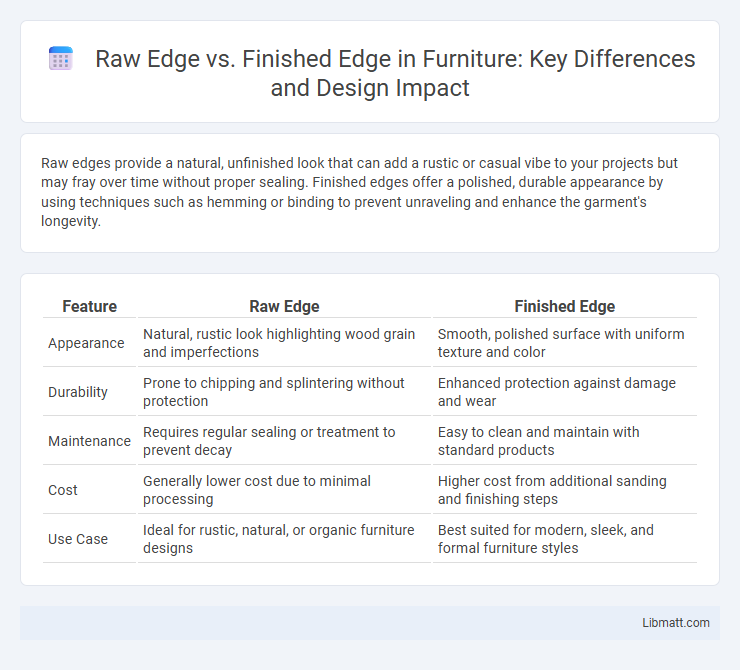Raw edges provide a natural, unfinished look that can add a rustic or casual vibe to your projects but may fray over time without proper sealing. Finished edges offer a polished, durable appearance by using techniques such as hemming or binding to prevent unraveling and enhance the garment's longevity.
Table of Comparison
| Feature | Raw Edge | Finished Edge |
|---|---|---|
| Appearance | Natural, rustic look highlighting wood grain and imperfections | Smooth, polished surface with uniform texture and color |
| Durability | Prone to chipping and splintering without protection | Enhanced protection against damage and wear |
| Maintenance | Requires regular sealing or treatment to prevent decay | Easy to clean and maintain with standard products |
| Cost | Generally lower cost due to minimal processing | Higher cost from additional sanding and finishing steps |
| Use Case | Ideal for rustic, natural, or organic furniture designs | Best suited for modern, sleek, and formal furniture styles |
Introduction to Raw Edge and Finished Edge
Raw edge refers to fabric that has been cut but left unhemmed or untreated, exposing the natural fibrils and making it prone to fraying over time. Finished edge involves techniques such as hemming, stitching, or binding that reinforce the fabric border, enhancing durability and aesthetic appeal. Choosing between raw edge and finished edge depends on the desired look, fabric type, and the garment's functional requirements.
Understanding Raw Edge: Definition and Uses
Raw edge refers to fabric edges that have not been hemmed, stitched, or treated to prevent fraying, often left intentionally in fashion and design for a rustic, unfinished look. Common in denim, leather goods, and contemporary clothing, raw edges provide a textural contrast and a unique aesthetic appeal that highlights handmade or artisanal qualities. Designers use raw edges to emphasize authenticity and creativity, while also reducing production time and costs by avoiding additional finishing processes.
What is a Finished Edge? Key Features
A finished edge refers to a fabric or material boundary that has been treated or sewn to prevent fraying, ensuring durability and a clean appearance. Key features include reinforced stitching, folded hems, or binding that maintain the structural integrity of the edge. This treatment enhances both the aesthetic quality and longevity of garments or textiles.
Visual Differences: Raw Edge vs Finished Edge
Raw edges display a natural, unrefined look with visible fabric texture and irregularities, whereas finished edges present a clean, polished appearance achieved through hemming, binding, or serging. The visible stitches or fraying in raw edges convey a rugged, casual aesthetic, while finished edges enhance durability and provide a sleek, professional look. Choosing between raw and finished edges directly impacts the garment's overall tone, influencing whether it appears more rustic or refined.
Durability and Maintenance Comparison
Raw edge fabric tends to fray over time, reducing overall durability and requiring frequent trimming or reinforcement. Finished edges enhance durability by preventing unraveling and provide a cleaner appearance with minimal maintenance. Choosing finished edges significantly lowers long-term care efforts and extends the fabric's lifespan in high-use applications.
Aesthetic Appeal: Style Impacts of Each Edge
Raw edge designs offer a rugged, organic aesthetic that highlights natural textures and imperfections, creating a bold, contemporary statement in your space. Finished edges provide a polished, clean look with smooth contours that enhance sophistication and visual refinement. Choosing between raw and finished edges shapes the style impact by balancing modern rustic charm against classic elegance in your interior design.
Common Applications in Fashion and Upholstery
Raw edges are frequently used in casual fashion and trendy streetwear, providing a rugged, unfinished look favored in denim jackets and distressed jeans. Finished edges dominate in upholstery, offering durability and a polished appearance essential for sofas and armchairs, achieved through techniques like hemming or binding. Your choice between raw and finished edges significantly impacts the garment's or furniture's aesthetic and longevity.
Pros and Cons: Raw Edge vs Finished Edge
Raw edges offer a rustic, natural look and quicker production time but may fray and lack durability, requiring additional care or sealing. Finished edges provide a polished, professional appearance with enhanced durability and resistance to fraying, though they involve more labor and cost. Choosing between raw and finished edges depends on the desired aesthetic, usage, and maintenance considerations of the project.
Tips for Choosing the Right Edge Technique
Choosing the right edge technique depends on your project's fabric type, intended durability, and aesthetic preference. Raw edges offer a casual, textured look suitable for woven or non-fraying materials, while finished edges provide clean, polished lines ideal for garments requiring strength and longevity. Assess your fabric's fraying tendency and maintenance needs to ensure your edge technique complements your design and prolongs your garment's life.
Conclusion: Which Edge Is Best for Your Project?
Choosing between a raw edge and a finished edge depends on the specific needs and aesthetic goals of your project. Raw edges offer a natural, rustic look and save time but may fray or deteriorate without proper treatment, while finished edges provide durability, a polished appearance, and added protection. Your decision should balance the desired visual style with the required strength and longevity for the intended use.
Raw edge vs finished edge Infographic

 libmatt.com
libmatt.com